
ADVENSER provides BIM services in the following domains:
MEP | Architecture | Structural | HVAC | Facade
Advenser realizes the advantage and significance of BIM (Building Information Modeling) to the world-wide construction industry today, and work alongside Architects, General contractors, Builders, Home owners and Engineers to present their work in a Building Information Model, enabling them to cut down on time and costs, offering them more value for money than can be provided from 2D Drafting. We specialize in providing BIM services to the AEC industry for many years. Our services include 3D BIM Modeling, Revit modeling , 4D BIM Services and architectural 3D Modeling requirements.
See our BIM samples for architectural section
Advenser providing Building Information Modeling services in MEP/ HVAC, structural and facade industries as well.
Our expertise in Architectural BIM includes:
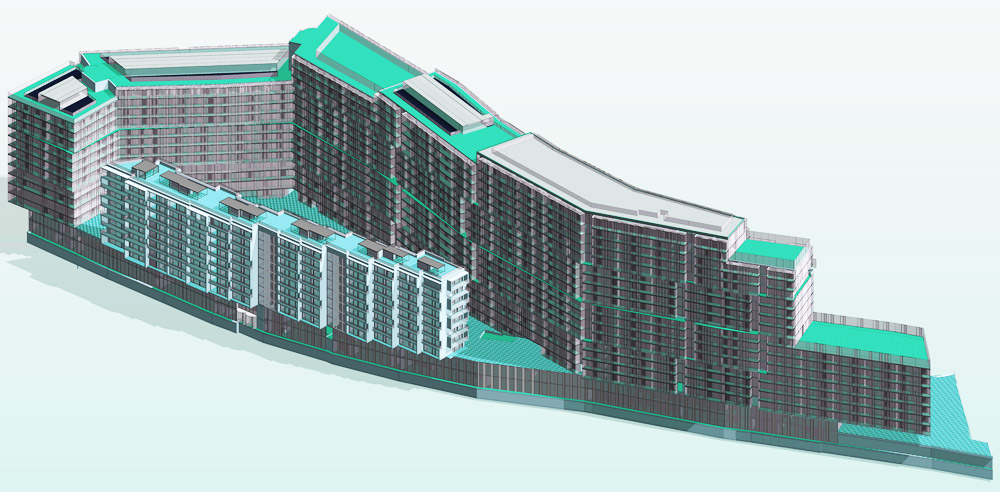

- LOD 100 (Conceptual modeling)
- LOD 200 (General modeling)
- LOD 300 (Accurate modeling & shop drawings)
- LOD 400 (Fabrication & Assembly)
- LOD 500 (Maintenance & Operations)
These 5 different levels have been classified and accepted by the American Institute of Architects (AIA) in BIM Protocol (E202).
LOD100
Model Content Requirements
Overall building mass indicative of area, height, volume, location and orientation may be modeled in three dimensions or represented by other data.
Authorized Uses
Analysis- The Model may be analyzed based on volume, area and orientation by application of generalized performance criteria assigned to the representative model elements.
Cost Estimation
The model may be used to develop cost estimates based on current area, volume or similar conceptual estimating techniques (e.g., square feet of floor area, condominium unit, hospital bed, etc.)
Schedule
The model may be used for project phase scheduling and overall duration.
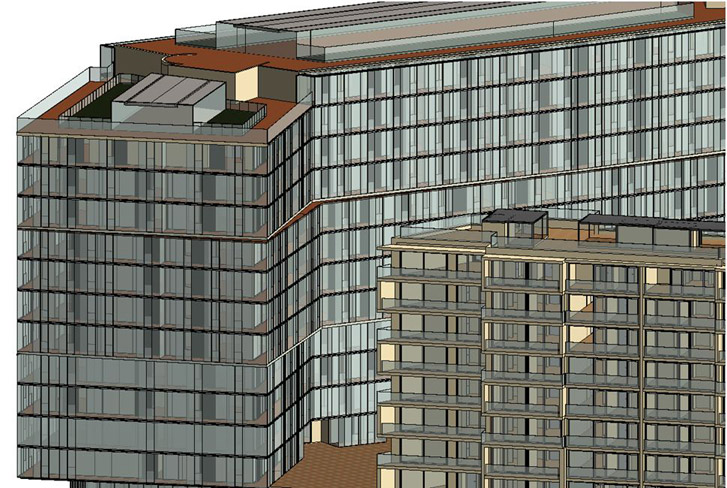
LOD 200
Model Content Requirements
Model Elements are modeled as generalized systems or assemblies with approximate quantities, size, shape, location, and orientation. Non-geometric information can also be attached to the model elements.
Authorized Uses
Analysis- The Model can be analyzed for performance of selected systems by application of generalized performance criteria assigned to the corresponding model elements.
Cost Estimating
The Model can be used to develop a cost estimate based on the approximate data furnished and conceptual estimating techniques (e.g., volume and quantity of elements or type of
System selected).
Schedule
The Model may be used to show ordered, time-scaled appearance of major elements and systems.
LOD 300
Model Content Requirements
Model elements are modeled as specific assemblies and are precise in quantity, size, shape, location, and orientation. Non-geometric information can also be attached to model elements.
Authorized Uses
Construction- Suitable for the derivation of traditional construction documents and shop drawings.
Analysis- The Model may be analyzed for performance of selected systems by applying specific performance criteria assigned to the corresponding Model Elements.
Cost Estimation
The Model may be used to develop a cost estimate based on the specific data provided and conceptual estimation techniques.
Schedule
The Model may be used to show an orderly, time-scaled appearance of detailed elements and systems.
LOD 400
Model Content Requirements
Model elements are modeled as specific assemblies that are precise in size, shape, location, quantity, and orientation with complete fabrication, assembly, and detailing information. Non-geometric information can also be attached to model elements.
Authorized Uses
Construction- Model elements are considered as virtual representations of the proposed element and are suitable for construction.
Analysis-The Model can be analyzed for performance of approved selected systems based on specific model elements.
Cost Estimation
Costs are based on the actual cost of specific components during procurement.
Schedule
The Model can be used to show an orderly, time-scaled appearance of detailed specific elements and systems including construction means and methods.
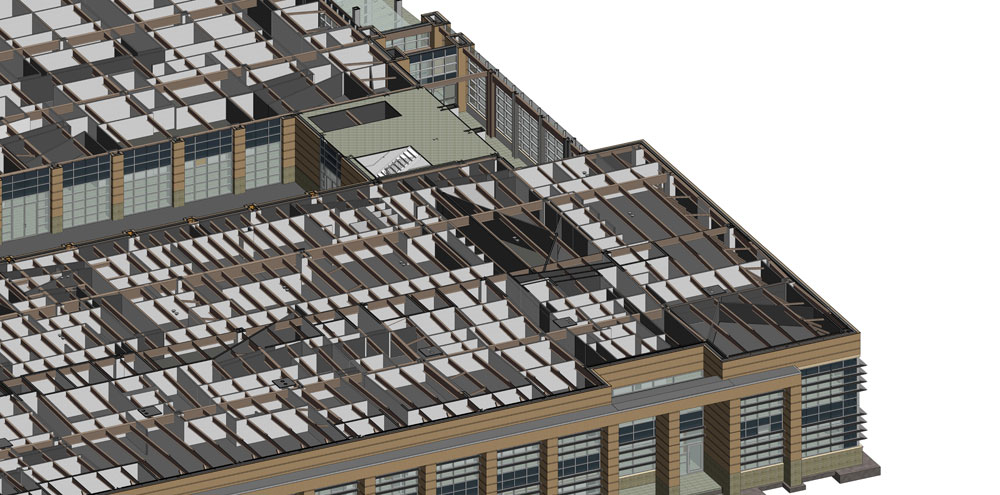
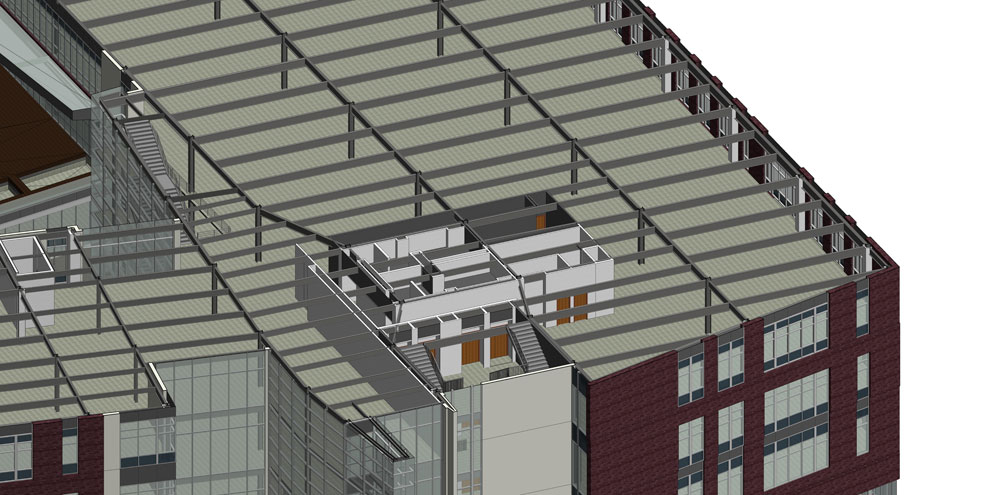
LOD 500
Model Content Requirements
Model Elements are modeled as constructed assemblies which are actual and accurate in size, shape, location, quantity, and orientation. Non-geometric information can also be attached to modeled elements.
Authorized Uses
General Usage-The model can be used to maintain, alter and add to the project, but only to the extent consistent with any licenses granted in the Agreement or as specified in a separate licensing agreement.
Benefits of BIM
The various benefits of BIM as enjoyed by the different parties involved are listed below.
During Pre-Construction stage
- Allows to verify if the proposed design is feasible financially
- If not, it instantly creates a new design within the constraints of desired time/cost parameters
- Allows architecture/engineering documentation
During Desiging stage
-
3D visualization during any stage of design process
-
Accurate 2D drawings extraction during design
-
Determines if the 3D model is constructible at the site
-
Extraction of parameters for sustainable building design performance analysis and evaluation
-
Analysis and correction of building design in detail
-
Contains intricate details on the structure, site and proposed materials of the building
-
Enables accuracy in cost estimates and budget control
During Construction & Fabrication stage
-
Accurate visualization of the building with real time parameters
-
Better onsite coordination of services in construction sequencing
-
Detects conflicts or clashes and allows resolution for the entire building
-
Reflection of a minor change in the digital database throughout the model
-
Construction documents creation containing minute information regarding the structure, quantities, materials
-
Easy facility management and maintenance
A comparison of traditional delivery methods vs. Integrated Project Delivery (IPD) methods
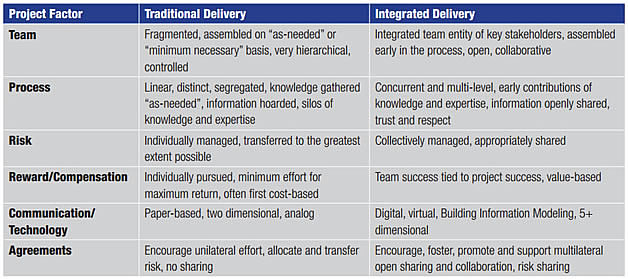
Product Name |
Manufacturer |
Primary Function |
Cadpipe HVAC |
AEC Design Group |
3D HVAC Modeling |
Revit Architecture |
Autodesk |
3D Architectural Modeling and parametric design. |
AutoCAD Architecture |
Autodesk |
3D Architectural Modeling and parametric design. |
Revit Structure |
Autodesk |
3D Structural Modeling and parametric design. |
Revit MEP |
Autodesk |
3D Detailed MEP Modeling |
AutoCAD MEP |
Autodesk |
3D MEP Modeling |
AutoCAD Civil 3D |
Autodesk |
Site Development |
DProfiler |
Beck Technology |
3D conceptual modeling wi |
Bentley BIM Suite (MicroStation, Bentley Architecture, Structural, Mechanical, Electrical, Generative Design) |
Bentley Systems |
3D Architectural, Structural, Mechanical, Electrical, and Generative Components Modeling |
Fastrak |
CSC (UK) |
3D Structural Modeling |
SDS/2 |
Design Data |
3D Detailed Structural Modeling |
Fabrication for AutoCAD MEP |
East Coast CAD/CAM |
3D Detailed MEP Modeling |
Digital Project |
Gehry Technologies |
CATIA based BIM System for Architectural, Design, Engineering, and Construction Modeling |
Digital Project MEP Systems Routing |
Gehry Technologies |
MEP Design |
ArchiCAD |
Graphisoft |
3D Architectural Modeling |
MEP Modeler |
Graphisoft |
3D MEP Modeling |
HydraCAD |
Hydratec |
3D Fire Sprinkler Design and Modeling |
FireCad |
Mc4 Software |
Fire Piping Network Design and Modeling |
CAD-Duct |
Micro Application |
3D Detailed MEP Modeling |
Vectorworks Designer |
Nemetschek |
3D Architectural Modeling |
RISA |
RISATechnologies |
Full suite of 2D and 3D Structural Design Applications |
Tekla Structures |
Tekla |
3D Detailed Structural Modeling |
Vico Office |
Vico Software |
5D Modeling which can be used to generate cost and schedule data |
PowerCivil |
Bentley Systems |
Site Development |
Site Design, Site Planning |
Eagle Point |
Site Development |


